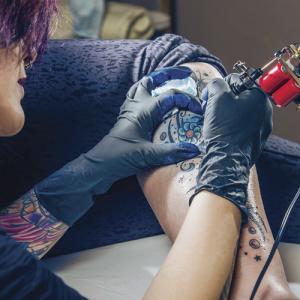Q. I’m having an MRI and I heard that tattoos can present problems for this test. True?
True. Tattoos can create a misdiagnosis with Magnetic Resonance Imaging because there is metal in many tattoo pigments. Magnets attract metals. So, tattoo pigments may interfere with the quality of the image from an MRI. In some rare cases, people experience swelling or burning in the tattoo when they have an MRI.
If you have a tattoo, you should discuss it with your doctor before undergoing an MRI.
A tattoo is made with pigments injected into the skin’s top layer. A needle connected to a machine with dye tubes pierces the skin repeatedly. A large tattoo can take several hours. The process involves some bleeding and pain.
Tattoos are very popular today. According to U.S. News & World Report, there are more than 20,000 tattoo parlors operating in the United States.
A study done by the Journal of the American Academy of Dermatology found that almost one in four Americans between 18 and 50 are tattooed. I was unable to find any statistics about how many seniors are getting new tattoos. My suspicion is that there aren’t many of my contemporaries heading to tattoo parlors, although there are some with body art left over from their youth.
During my research, I found an auction on Ebay for "Over-the-Hill Temporary Tattoos" for senior parties. I could not resist sharing some of these: Bite Me with dentures in a glass, Retirement Home Boy with skull and crossbones, Born to Ride across an electric scooter with flames, and Who’s Your Grand Daddy? over an anchor.
Complications from tattoos are relatively uncommon. However, there are risks that include: blood-borne diseases such as hepatitis, tetanus, tuberculosis and HIV/AIDS; granulomas, which are bumps that can form around a tattoo; keloids, which are scars that grow beyond normal boundaries; local bacterial infections; and allergic reactions.
If you decide to get a tattoo, make sure the establishment is licensed and reputable.
Many people who get tattoos decide they want them removed because the artwork faded, became blurred or because their body changed with age. There are a variety of removal methods, but none of them is perfect. Removal methods include:
• Laser. A surgeon removes the tattoo by treating the pigment with a high-intensity laser beam. Many treatments may be needed to lighten the tattoo. The process may not completely erase the artwork. Laser surgery is the most common method used today.
• Brush. The tattoo is removed by dermabrasion, a technique that uses a wire brush or a diamond wheel to remove skin. This technique may leave a scar.
• Scalpel. A surgeon cuts out the tattoo and closes the wound with stitches. This technique is effective in removing some tattoos. This surgery can leave a scar.
Tattoos can be removed by a dermasurgeon on an outpatient basis with local anesthesia.























































